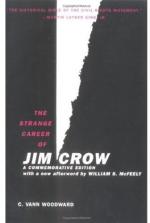
|
| Name: _________________________ | Period: ___________________ |
This test consists of 15 multiple choice questions and 5 short answer questions.
Multiple Choice Questions
1. Who was the leader of the National Urban League?
(a) Jones.
(b) Jordan.
(c) Jameson.
(d) Jackson.
2. New Orleans was a unique city in the South. The author refers to it as being which type of city?
(a) Unaffected.
(b) Accepting.
(c) Opportunistic.
(d) Color blind.
3. Historians and sociologists find that certain things were hard to measure. What were those things?
(a) Hopes and dreams.
(b) Ideas and morals.
(c) Segregation and integration.
(d) Reality and fiction.
4. How many years did it take for the Supreme Court to strictly enforce the Brown decision?
(a) 10.
(b) 15.
(c) 12.
(d) 8.
5. At its peak, how many members belonged to the white supremacy organization?
(a) 3.5 million.
(b) 8 million.
(c) 5 million.
(d) 2 million.
6. Where was this particular speech delivered?
(a) Washington, DC.
(b) New York, NY.
(c) Atlanta, GA.
(d) Little Rock, AR.
7. In which two states did Kennedy attempt to force integration?
(a) Alabama and Mississippi.
(b) Tennessee and Georgia.
(c) North Carolina and Arkansas.
(d) South Carolina and Oklahoma.
8. The NAACP file suits against how many school boards throughout the Deep South?
(a) 150.
(b) 143.
(c) 170.
(d) 182.
9. The landmark court case discussed throughout the book is Oliver Brown v. The Board of Education of ________.
(a) Knoxville, Tennessee.
(b) Atlanta, Georgia.
(c) Montgomery, Alabama.
(d) Topeka, Kansas.
10. In what year was the Civil Rights Act made into law?
(a) 1960.
(b) 1958.
(c) 1964.
(d) 1963.
11. What two states were controlled by members of the KKK at this time?
(a) Arkansas and Virginia.
(b) Alabama and Louisiana.
(c) Oklahoma and Texas.
(d) South Carolina and Georgia.
12. Which of the following was not a word used to describe the downtrodden state of many of the supporters of racial equality?
(a) Tired.
(b) Discredited.
(c) Weakened.
(d) Complacent.
13. Who was president at the time of the event?
(a) Herbert Hoover.
(b) Franklin Roosevelt.
(c) Zachary Taylor.
(d) James Buchanan.
14. Men involved in scientific pursuits are often referred to as "men of _____ and science."
(a) Mathematics.
(b) Education.
(c) Intellect.
(d) Letters.
15. Which is not mentioned in the list of things blacks are still being denied?
(a) Healthcare.
(b) Education.
(c) Right to vote.
(d) Income equality.
Short Answer Questions
1. One idea was to develop a separate _____ office to maintain segregation in public facilities.
2. How many children were killed during the time of the church bombing?
3. Many people compared the South to the politics of what other country?
4. The appointment of a(n) _________ in South Carolina fueled even more racial violence.
5. What is the name for the restrictive foreign politics?
|
This section contains 379 words (approx. 2 pages at 300 words per page) |

|




